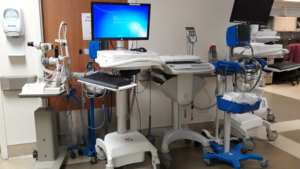
Complete Visibility Critical for Healthcare Wi-Fi Networks

It’s easier to solve problems when you have all the information. This is as true for Wi-Fi network issues as it is for anything else. But what does it mean to have all the information? In the world of IT, this is known as complete visibility and it’s a key capability for healthcare organizations that want optimized, secure, issue-free Wi-Fi networks.
Complete visibility is achieved faster and more reliably with AI-powered Wi-Fi optimization
With healthcare networks consisting of hundreds or thousands of connected devices, it’s impossible for human IT teams to analyze the performance and health of every device every second of the day. However, this is what is needed for complete visibility.
The answer? AI-powered Wi-Fi optimization.
Wi-Fi optimization solutions automate the analytics processes necessary for complete visibility. This means that IT teams have complete visibility immediately, in real-time, at all times.
Let’s break down what that looks like.
Complete visibility starts with end user quality testing
Can you answer the following questions?
- What do doctors, nurses, administrators, and all medical professionals and staff think of the Wi-Fi?
- Are they experiencing intermittent issues or dropped connections?
- Are they all using the new software that was recently installed?
- Are they having trouble accessing certain applications?
A network is only as good as its end users think it is. Rather than keeping IT teams dependent on end users for insights – for example, through surveys and problem tickets – teams should have independent access to end user quality metrics.
With these analytics, they know exactly what the user experience is at all times. They can proactively troubleshoot issues, and suggest improvements to network design and infrastructure as needed.
Hospitals should work with an optimization solution that will connect to the network as an end user device to run tests. This ensures that IT has complete UX visibility.
Visibility goes beyond a hospital’s Wi-Fi
If IT wants complete visibility, they have to go beyond what’s connected to an organization’s wireless network. For the best results, they require insight into the radio frequency (RF) environment that all networks operate within.
This environment includes:
- Backend and frontend infrastructure
- All connected devices (medical devices, as well as staff, patient, and visitor devices)
- Applications
- Nearby networks sharing the airspace
- Non-Wi-Fi devices sharing the airspace (microwaves, Bluetooth, etc.)
Any one of these elements can impact network performance. If IT doesn’t have a way to see the entire RF ecosystem, teams don’t have complete visibility. This visibility should be delivered in a single dashboard view.
Visibility should include meaningful data
It’s one thing to know that there are:
- 1500 devices connected to the network,
- 1 nearby network sharing the airspace, and
- 3 microwaves in the RF environment.
It’s another to know that
- 1 of the connected devices is an unauthorized AP
- 300 of the devices are Wi-Fi 6 capable
- 700 devices are connected to the 2.4GHz frequency
- 4 devices show open ports
- 2 of the microwaves are affecting nearby Wi-Fi-connected communication devices
The first set of information builds IT a picture of the network, but the second enhances teams’ understanding of network health.
More data isn’t always better, but more meaningful data is. Any Wi-Fi optimization platform that IT uses for complete visibility should provide data that IT can quickly access and use to further understand the end user experience.
Proactive alerts and actionable resolutions take visibility to the next level
If one of the benefits of complete visibility is having all the information needed to resolve issues, how much better would it be to be alerted to issues before they are impacting end users?
Defined this way, complete visibility moves beyond a passive capability and becomes something that proactively works for optimization.
Thanks to artificial intelligence technology, it’s possible. An AI-powered platform will learn to recognize normal network behavior. When anything abnormal happens, it can immediately alert IT. This allows teams to proactively troubleshoot, a change from the old, reactive system dependent on Wi-Fi problem tickets.
Depending on the AI platform used, IT can also receive root cause identification and actionable resolutions. This means that teams know:
- That there’s a network issue
- The impact the issue is having on end users
- The root cause of the issue
- Steps needed to resolve the issue
In other words, the alerts now provide complete visibility.
Visibility isn’t location-specific
Issue identification shouldn’t be dependent on the location of IT professionals. Teams should have complete network visibility and the ability to troubleshoot from any location at any time. That means all Wi-Fi optimization solutions should be remote capable.
Future-proofing is the final step
Finally, complete visibility for healthcare organizations includes visibility into future network needs.
This is delivered via historical data and analytics. These analytics reveal long-term trends in network health and performance. This supports administrators when they must decide what upgrade/update investments are needed to meet their specific hospital’s needs.
With these analytics, they can answer questions such as:
- Are any access points showing signs of degradation?
- Is the network nearing capacity?
- Which floors of a hospital show the most dense deployment of devices?
Reliable Wi-Fi calls for complete visibility
Since the importance of Wi-Fi in healthcare can’t be overstated – it supports not only mission critical but also life critical devices – anything that protects network performance is important.
The Wireless Intelligence Platform™ (WIP), an AI-powered Wi-Fi optimization solution using intelligent sensors and agents, provides:
- End user quality metrics
- Root cause identification
- Actionable resolutions
- Proactive alerts
- Remote visibility and troubleshooting
- Historical wireless traces
WIP provides Wi-Fi assurance – Wi-Fi that works optimally, 24/7. Hospitals that use the solution experience:
- 90% faster Mean-Time-to-Resolution (MTTR)
- 70% fewer Wi-Fi problem tickets
- 80% fewer remote site visits
Bring cost-effective, AI-powered visibility to your hospital today. Ask us about a free demo or trial.
Wyebot is transforming how organizations optimize their business-critical Wi-Fi networks. Our AI-powered Wireless Intelligence Platform combines intelligent sensors and agents with cloud-based software to analyze Wi-Fi networks from the end-user perspective, automatically detecting both intermittent and critical issues, and proactively recommending solutions. Trusted by leading enterprises, healthcare organizations, and educational institutions worldwide, Wyebot’s vendor-agnostic platform reduces mean time to resolution by up to 90% and eliminates up to 80% of onsite troubleshooting visits. Headquartered in Massachusetts, Wyebot continues to set new standards in wireless network reliability.

